Insecticidal decay effects of long-lasting insecticide nets and indoor residual spraying on Anopheles gambiae and Anopheles arabiensis in Western Kenya
- PMID: 26567915
- PMCID: PMC4644290
- DOI: 10.1186/s13071-015-1194-6
Insecticidal decay effects of long-lasting insecticide nets and indoor residual spraying on Anopheles gambiae and Anopheles arabiensis in Western Kenya
Abstract
Background: Indoor residual spraying (IRS) and long-lasting insecticidal nets (LLINs) are the first-line tools for malaria prevention and control in Africa. Vector resistance to insecticides has been extensively studied, however the insecticidal effects of the nets and sprayed walls on pyrethroid resistant mosquitoes has not been studied thoroughly. We evaluated the bioefficacy of LLINs of different ages and lambda-cyhalothrin (ICON 10cs) on the sprayed mud walls for a period of time on malaria vector survivorship.
Methods: WHO tube bioassay was performed using diagnostic doses of lambda-cyhalothrin (0.05%), permethrin (0.75%) and deltamethrin (0.05%). Cone bioassays were conducted on netting materials from 0 to 3 years old long-lasting insecticide-impregnated nets. Wall bioassays were performed monthly on mud slabs sprayed with lambdacyhalothrin over a period of seven months. All bioassays used An. gambiae mosquitoes collected from the field and the laboratory susceptible reference Kisumu strain. Concentration of the insecticides on the netting materials was examined using the gas chromatography method. Mosquitoes were identified to species level using PCR and genotyped for the kdr gene mutation frequencies.
Results: WHO bioassays results showed that populations from five sites were highly resistant to the pyrethroids (mortalities ranged from 52.5 to 75.3%), and two sites were moderately resistant to these insecticides (80.4 - 87.2%). Homozygote kdr mutations of L1014S ranged from 73 to 88% in An. gambiae s.s. dominant populations whereas L1014S mutation frequencies were relatively low (7-31%) in An. arabiensis dominant populations. There was a significant decrease (P < 0.05) in mosquito mortality with time after the spray with both lambda-cyhalothrin (75% mortality after six months) and with the age of LLINs (60% mortality after 24 month). Field collected mosquitoes were able to survive exposure to both IRS and LLINs even with newly sprayed walls (86.6-93.5% mortality) and new LLINs (77.5-85.0% mortality), Wild mosquitoes collected from the field had significantly lower mortality rates to LLINs (59.6-85.0%) than laboratory reared susceptible strain (100%). Insecticide concentration decreased significantly from 0.14 μg/ml in the new nets to 0.077 μg/ml in nets older than 18 months (P < 0.05).
Conclusion: This study confirms that insecticide decay and developing levels of resistance have a negative contribution to reduced efficacy of ITN and IRS in western Kenya. These factors contribute to decreased efficacy of pyrethroid insectides in ongoing malaria control programs. In order to mitigate against the impact of insecticide resistance and decay it is important to follow the WHO policy to provide the residents with new LLINs every three years of use while maintaining a high level of LLINs coverage and usage. There is also need for urgent development and deployment of non-pyrethroid based vector control tools.
Figures
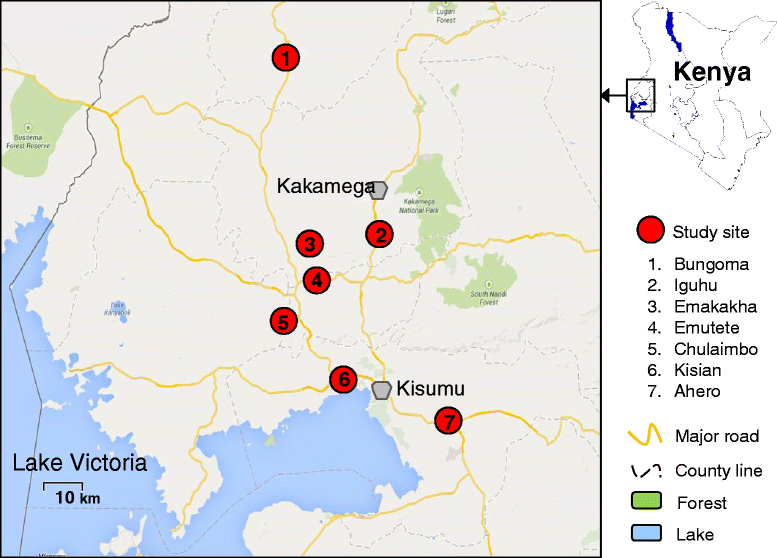
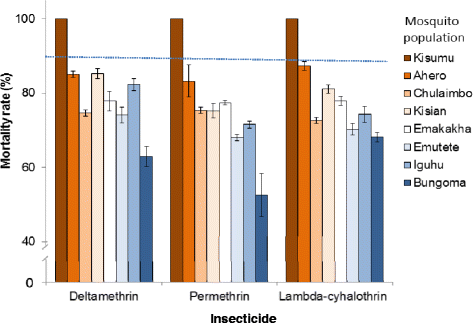
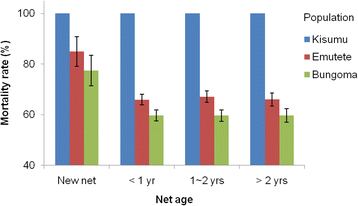
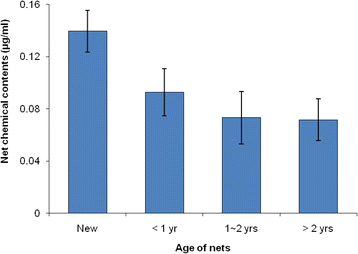
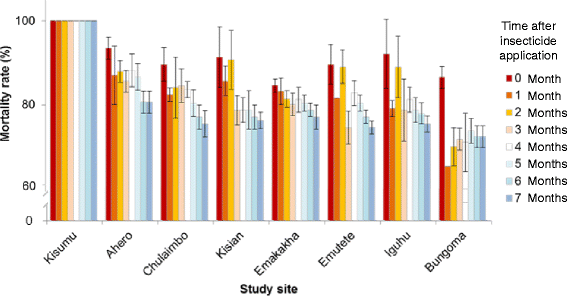
Similar articles
-
Implications of bio-efficacy and persistence of insecticides when indoor residual spraying and long-lasting insecticide nets are combined for malaria prevention.Malar J. 2012 Nov 19;11:378. doi: 10.1186/1475-2875-11-378. Malar J. 2012. PMID: 23164062 Free PMC article.
-
Aging partially restores the efficacy of malaria vector control in insecticide-resistant populations of Anopheles gambiae s.l. from Burkina Faso.Malar J. 2012 Jan 23;11:24. doi: 10.1186/1475-2875-11-24. Malar J. 2012. PMID: 22269002 Free PMC article.
-
Bioefficacy of long-lasting insecticidal nets against pyrethroid-resistant populations of Anopheles gambiae s.s. from different malaria transmission zones in Uganda.Parasit Vectors. 2013 May 2;6:130. doi: 10.1186/1756-3305-6-130. Parasit Vectors. 2013. PMID: 23634798 Free PMC article.
-
Indoor residual spraying for preventing malaria in communities using insecticide-treated nets.Cochrane Database Syst Rev. 2022 Jan 17;1(1):CD012688. doi: 10.1002/14651858.CD012688.pub3. Cochrane Database Syst Rev. 2022. PMID: 35038163 Free PMC article. Review.
-
Current vector control challenges in the fight against malaria.Acta Trop. 2017 Oct;174:91-96. doi: 10.1016/j.actatropica.2017.06.028. Epub 2017 Jul 3. Acta Trop. 2017. PMID: 28684267 Review.
Cited by
-
An analytically tractable, age-structured model of the impact of vector control on mosquito-transmitted infections.PLoS Comput Biol. 2024 Mar 14;20(3):e1011440. doi: 10.1371/journal.pcbi.1011440. eCollection 2024 Mar. PLoS Comput Biol. 2024. PMID: 38484022 Free PMC article.
-
Bioefficacy and durability of Olyset® Plus, a permethrin and piperonyl butoxide-treated insecticidal net in a 3-year long trial in Kenya.Infect Dis Poverty. 2021 Dec 20;10(1):135. doi: 10.1186/s40249-021-00916-2. Infect Dis Poverty. 2021. PMID: 34930459 Free PMC article. Clinical Trial.
-
Modelling the Impact of Vector Control on Lymphatic Filariasis Programs: Current Approaches and Limitations.Clin Infect Dis. 2021 Jun 14;72(Suppl 3):S152-S157. doi: 10.1093/cid/ciab191. Clin Infect Dis. 2021. PMID: 33905475 Free PMC article. Review.
-
Behavioral response of insecticide-resistant mosquitoes against spatial repellent: A modified self-propelled particle model simulation.PLoS One. 2020 Dec 29;15(12):e0244447. doi: 10.1371/journal.pone.0244447. eCollection 2020. PLoS One. 2020. PMID: 33373422 Free PMC article.
-
Adaptive interventions for optimizing malaria control: an implementation study protocol for a block-cluster randomized, sequential multiple assignment trial.Trials. 2020 Jul 20;21(1):665. doi: 10.1186/s13063-020-04573-y. Trials. 2020. PMID: 32690063 Free PMC article.
References
-
- WHO . World Malaria Report. Geneva: WHO; 2012.
-
- Ochomo EO, Bayoh NM, Walker ED, Abongo BO, Ombok MO, Ouma C, Githeko AK, Vulule J, Yan G, Gimnig JE. The efficacy of long-lasting nets with declining physical integrity may be compromised in areas with high levels of pyrethroid resistance. Malar J. 2014;12:368. doi: 10.1186/1475-2875-12-368. - DOI - PMC - PubMed
-
- Protopopoff N, Matowo J, Malima R, Kavishe R, Kaaya R, Wright A, West PA, Kleinschmidt I, Kisinza W, Mosha FW, Rowland M. High level of resistance in the mosquito Anopheles gambiae to pyrethroid insecticides and reduced susceptibility to bendiocarb in north-western Tanzania. Malar J. 2013;12:149. doi: 10.1186/1475-2875-12-149. - DOI - PMC - PubMed
Publication types
MeSH terms
Substances
Grants and funding
LinkOut - more resources
Full Text Sources
Other Literature Sources

